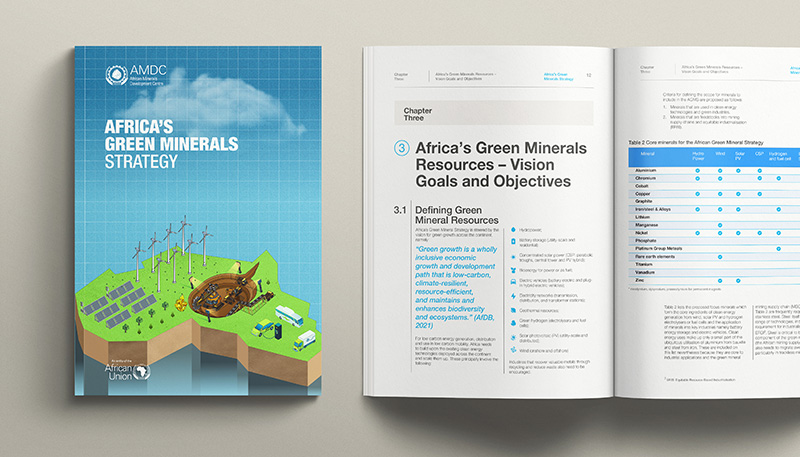Unpacking the African Green Mineral Strategy: A Q&A Discussion with Kudakwashe Manjonjo of Power Shift Africa

Posted on 2 June 2025
Discover how Africa’s Green Minerals Strategy aims to turn its mineral wealth into a springboard for climate resilience, industrialisation and shared prosperity, with Power Shift Africa.
Executive Summary
- The African Green Minerals Strategy (AGMS), adopted by the AU in February 2025, charts a path to leveraging Africa’s mineral wealth for a just, sustainable and industrialised future.
- The strategy reframes the narrative from ‘critical’ to ‘green’ minerals, focusing on decarbonisation, energy access and structural transformation in Africa rather than merely securing supply for the Global North.
- The four pillars of the strategy focus on advancing mineral development, developing people and technology, building key value-chains, and practising mineral stewardship.
- Key policy tools include harmonising trade rules under the AfCFTA, protecting nascent industries, and creating mechanisms to share benefits equitably across the continent.
Adopted by the African Union (AU) Executive Council in February 2025, the African Green Minerals Strategy (AGMS) represents the AU’s mineral resources strategy for a just transition and decarbonised future. Developed as a collaborative effort by the African Minerals Development Centre, African Development Bank, African Legal Support Facility, and the United Nations Economic Commission for Africa, the AGMS provides a roadmap for harnessing Africa’s mineral wealth to drive value addition at source, regional industrialisation, and climate resilience. In addition, the Strategy aligns with the African Mining Vision by advocating for equitable and sustainable resource management, ensuring that mineral wealth translates into broad-based socio-economic development.
African Green Minerals Strategy (Strategy)
The questions that follow reflect on the major pillars and recommendations of the AGMS and are intended to support a broader conversation about the role of strategies, such as the AGMS, in providing a policy framework for the sustainable development of Africa’s mineral resources. The questions were posed to Kudakwashe Manjonjo, Just Transition Advisor at Power Shift Africa. This Strategy, alongside many other resources such as mineral profiles, news and strategies, can be found on the African Green Minerals Observatory website.
The African Green Mineral Strategy frames the discussion around ‘green’ as opposed to ‘critical’ minerals. Can you explain why this difference is not merely semantic and how the preference for the ‘green’ terminology reflects the African continent’s objectives and priorities for its minerals?
There is an inherent tension within the minerals landscape between the respective ‘critical’ and ‘green’ mineral narratives. On the one hand, the critical minerals narrative tends to focus on how the Global North – usually mineral consuming countries – can secure the supply chains of these minerals (e.g., lithium, cobalt, bauxite etc) for processing and application in their various industries, such as automotive, electronics, and military sectors.

On the other hand, you have the green minerals narrative which is predominantly from countries in the Global South – usually mineral producer countries where many of the mineral reserves are found and mined. This second narrative is where Africa lies since about 30-40% of these mineral reserves are found in Africa. This narrative focuses much more on emphasising the use of these minerals to build decarbonised economies. The preference for the green minerals terminology in Africa stresses their specific focus namely, to produce and supply minerals that can be used to address key issues facing the continent such as the energy poverty and a lack of structural transformation.
This divergence is also reflected in the fact that many countries apply this terminology to those minerals that aren’t necessarily thought of as important for the energy transition, but which nevertheless play a crucial role in different national economies. For example, Botswana’s economy relies on diamonds which makes diamonds a ‘critical’ mineral, but not necessarily a transition mineral. Or in South Africa where the government declared coal a ‘critical mineral’ even though it is not a ‘green mineral.’ The United Nations definition outlined in the UN Panel on Critical Minerals uses the term ‘critical energy transition minerals’ to bridge the narrative gap in the global landscape.
The African Green Mineral Strategy is not the first continental framework of its kind. Can you outline how the Strategy relates to existing frameworks such as the African Mining Vision and what the rationale was for developing a new continental framework on critical minerals?
The AMV is the vision while the AGMS is one of the strategies that implement that vision. Therefore, they are complementary and co-exist together as part of the body of pan-African policies. The AGMS is then not a new framework per se, but rather more of a natural progression from a vision to a strategy. In a sense, the AGMS can be understood as a framework inspired by the AMV, which accounts for the changing context since the AMV was developed in 2009 – specifically for the new growing global demand for critical minerals as this relates to Africa.
Practically and institutionally, the policies are operationalized through the Africa Minerals Development Centre (AMDC) which is the official AU body in charge of implementing mineral policies. Unfortunately, the AMDC has yet to be fully operationalised due to the lack of ratification of its statutes. Currently only 4 out the necessary 14 countries have ratified the AMDC, thereby limiting its power. This situation highlights the challenges facing frameworks such as AGMS, which are often at risk of implementation paralysis at the regional level due to the state-centric approach to mining policymaking followed by most African states.
The African Green Mineral Strategy is based on four pillars. Can you explain the importance of each pillar in achieving the objectives of the Strategy?
The four pillars of the AGMS are as follows:
- Advancing mineral development: Strengthening geological knowledge, exploration, and investment in mineral resource management
- Developing people and technological capability: Building skills, research capacity, and technological expertise to maximise Africa’s mineral potential
- Building key value-chains: Ensuring industrialisation through local beneficiation, green technology manufacturing, and mineral-based economic transformation
- Practising mineral stewardship: Promoting responsible mining, environmental sustainability, and circular economy principles
Advancing mineral development and developing people and technology capability should be understood as the primary hard infrastructure pillars. They deal with the basic needs of the strategy focusing on quantifiable mineral verification and investment prospects as well as building the human and intellectual capacity on the continent to make use of the verified geological information.
Building value chains is the secondary hard infrastructure pillar. This pillar relies on the first two where investment direction and cooperation is aimed at supporting those industries which form part of the resource-led industrialisation model. Rather than ‘development corridors’ where value chains are based on supplying global markets, the AGMS value chains are focused on building value chain ecosystems on the continent.
The last pillar, promoting mineral stewardship speaks to the culture and governance of the resource-led industrialisation model adopted by the AGMS. Rather than being viewed as the ESG addition, this pillar is better understood as providing the guiding parameters (stewardship) that informs the direction of the rest of the policy framework. It includes principles such as Free and Prior Informed Consent, and others such as the principle that not all mineral resources can or should be mined since there are human and environmental priorities that must also be respected and adhered to. It also informs the other reality that Africa cannot mine its minerals forever, hence the need for resource circularity.
The African Green Mineral Strategy puts forward several recommendations to realise its objectives. Can you unpack a few of these policy tools in more detail and discuss why they are necessary to achieve the vision of the Strategy?
There are two action points in the AGMS which can essentially be understood as one point, namely the need for Africa to build on its economies of scale within the minerals landscape. To that end, the AGMS outlines the need for Africa to finalise the Africa Free Trade Agreement (AfCFTA) rules of origin for motor vehicles; clean energy sources (PVs, windmills, batteries, etc.) and mining inputs. Agreeing to the rules of origin through AfCFTA and building a common tariff will increase intra-Africa trade and trigger the multiplier effect. Such policy measures should, in theory, also help to ensure that the proceeds of mineral investments are kept within the continent, thereby creating a virtuous cycle of development within a single continental market. In addition, the AGMS argues for the development of an Africa-wide common external tariff for select green minerals inputs and outputs with the aim of protecting nascent African industries from outside competition.
One point of potential about the African continent that is often underestimated is the continent’s 1.3 billion people becoming part of a single common market. The potential of this demographic dividend as seen in countries such as China and India is also viable in Africa. However, this potential is reduced by the construction of colonial borders, which in effect result in the development of over 50 different sets of rules and regulations that deal with the governance of mineral resources. What this effectively does is limit the ability of African governments, businesses, and people to move, trade, and network within simplified regulations. This status quo is still being driven by the fear of intra-African regional competitors for investment, which sees policymakers prioritise those policy approaches to minerals governance that operate largely on the national level, rather than the regional or continental level.
If there is one key insight from the African Green Minerals Strategy that policymakers should pay attention to, what do you think this insight is and why do you believe it is especially noteworthy?
An insight worth highlighting is the AGMS attempts to drive “equitable solutions to overcome uneven development”. A stark reality is the historical uneven development on the continent. This inequality in the minerals industry is compounded by the uneven distribution of green minerals and how much critical mass of a particular mineral each country has compared to others. In other words, in pursuing the sustainable development of Africa’s mineral resources, there is a risk that any policy measures adopted could exacerbate pre-existing inequality on the continent – the AGMS seeks to provide a solution to this problem.
The proposed solution is a compensation mechanism which uses local content requirements attached to mining licences as the instrument to build regional value chains that incentivises procurement from local suppliers in declining order from poorer member states, richer member states, and then from outside of continent. The idea is to promote value chain networks to grow beyond the more developed countries, in the hopes of expanding development corridors and deepening intra-Africa trade. This insight, although not perfect, provides a potential avenue for countries with less mineral resources or industrial development to actively participate in the AGMS and view participation in the AGMS beyond mineral extraction.